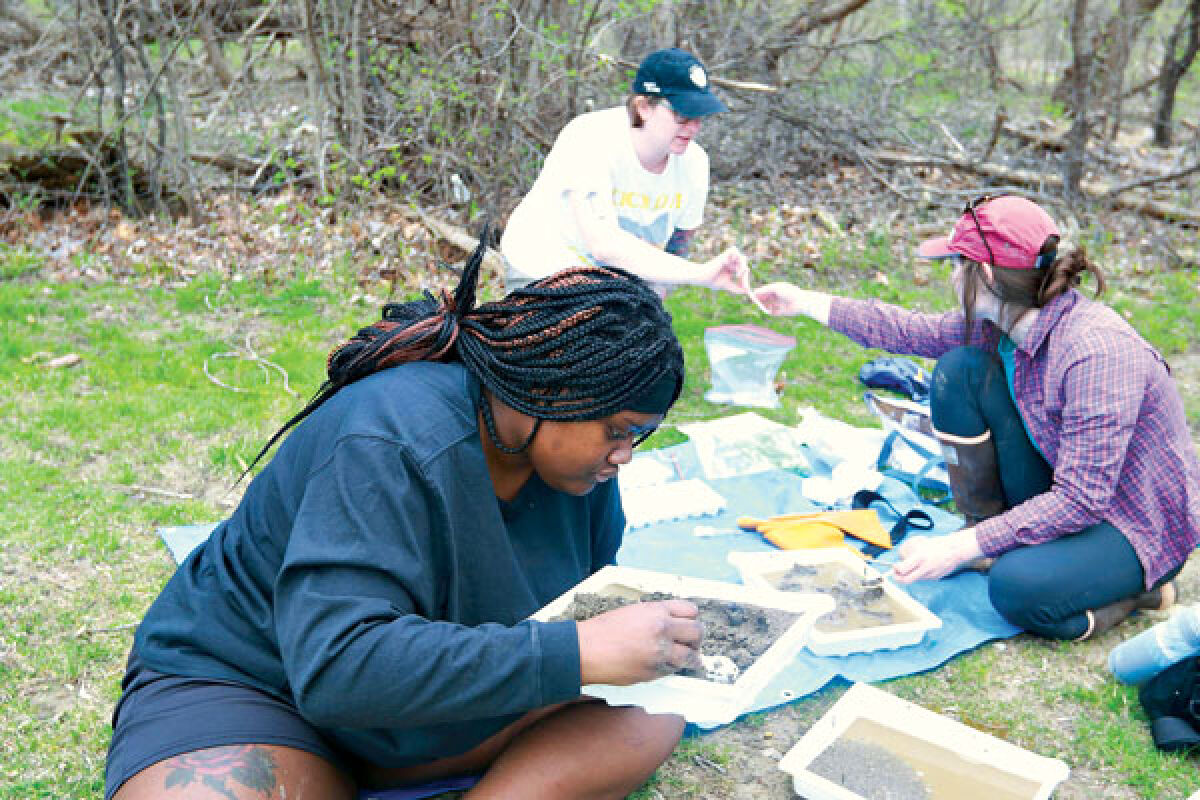
Steve Boegehold, of Clinton Township, joins in on the hunt with team leader Ben Kramer, of Ann Arbor, to collect water samples from the Rouge River in Southfield.
Photo by Erin Sanchez
METRO DETROIT — Insects don’t bug the Friends of the Rouge.
In fact, at the FOTR, they welcome what most consider to be pests. Every year since 1998, the group has been collecting insect samples in the winter, spring and fall.
In 2001, the Friends’ monitoring manager, Sally Petrella, looked to other local conservation groups to see how they conducted similar studies with larger volunteer rates. Reworking their current sampling model, the Friends then began a group sampling model and started providing training to their volunteers.
Now, the spring and fall Bug Hunts, and the winter Stonefly Search draw over 100 volunteers, from college students to citizen scientists, local environmentalists and others curious about what lies beneath the surface of the Rouge. With 27 sites to inspect for various species such as aquatic insects, snails, clams, mayfly larva, dragonfly larva and crayfish, 13 teams set out April 15 p.m. at this year’s spring Bug Hunt.
Petrella explained that the reason for this collection is that the bugs found help to provide more insight into the health of the river and quality of habitat.
“Some of these bugs, like the dragonfly larva, have lived there for as long as three years. So, their presence or absence is a really good indication of overall water quality. If there’s a problem at the site, if it gets polluted, they’re not going to be there anymore. In a way, it’s a better way to monitor the site than to go out and do water quality parameters like temperature, pH and dissolved oxygen. We do the monitoring to assess the sites where there might be restoration projects. And at another level, we’re just going out there to screen for problems.”
After the bugs are collected, they are preserved so that the Friends can examine and identify them further under a microscope. The bugs collected are also stored in long-term records.
“A few years ago, we found a new species of caddisflies that had not been identified in the state of Michigan,” Petrella said. “We were really excited about it, and because we had collections from past years, we could go back to see if we had found it before.”
Petrella details another exciting find during a Stonefly Search a few years back where stoneflies were detected in Detroit, near Eight Mile Road. According to Petrella, this was a surprising find because stoneflies are one of the most sensitive organisms, and you wouldn’t expect them that far downstream.
At each site, 100 bugs are collected.
“It’s a lot of bugs to collect and identify, and some of them are very tiny,” Petrella said. “But it’s giving us great information. By collecting them like this, we’ve had graduate students study our insect collection. We had one that did an analysis of heavy metals and went back and analyzed our caddisflies. We had some students looking at the genetics of the caddisfly population, and they actually traced when that new species of caddisflies came into the watershed.”
Anna Boegehold is an algal toxin and ecology research specialist at the University of Michigan’s Cooperative Institute for Great Lakes Research, and she is also a seasoned Bug Hunter.
Boegehold began participating in the FOTR’s Bug Hunt as a Ph.D. student at Wayne State University with her aquatic ecology lab. She continued her involvement a decade later and serves as a team leader; she explained that this has become a fun hobby that aligns with her professional life. Boegehold explains that the Rouge flows into the Detroit River, which is one of the main inputs of water in western Lake Erie, “so everything that we do in the Rouge impacts the ecosystem that I study.
“It’s a really cool program that influences research in the area. And they have a ton of data, like a couple of decades’ worth. Both my Ph.D. lab, which is Donna Kashian’s lab at Wayne State, and the lab I’m in now at Sigler have both used Friends of the Rouge data for scientific publications and research that they’ve done.”
Boegehold stated that this is a hobby that she’s invited her dad and her cousin to join in on.
“I started inviting my cousin, who is 14 years younger than me, when she was a preteen 10 years ago and got her interested. I moved back from being out of state for a few years, so she’s really excited to do the Bug Hunts again.”
For more information on the Friends of the Rouge, visit https://therouge.org.
To access the academic articles that used the FOTR’s data, visit sciencedirect.com/science/article/pii/S0022169422010459 and sciencedirect.com/science/article/abs/pii/S1470160X20304131.
 Publication select ▼
Publication select ▼























